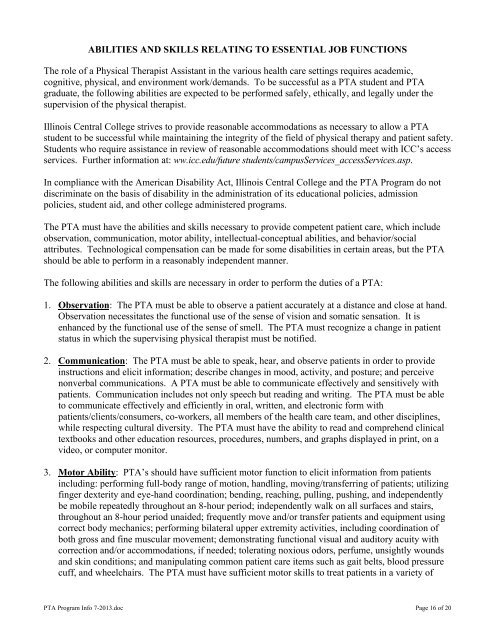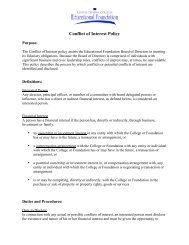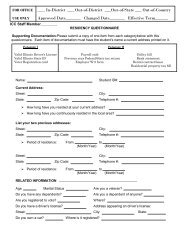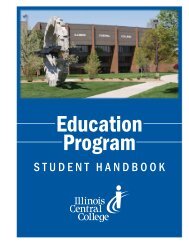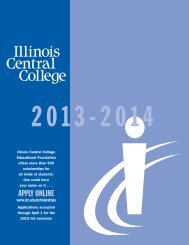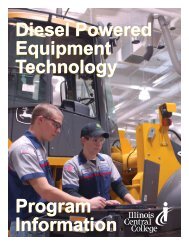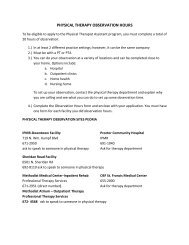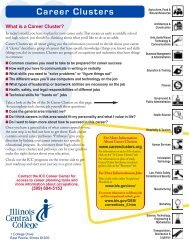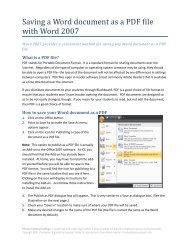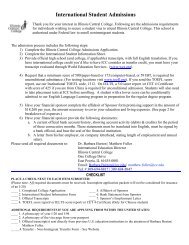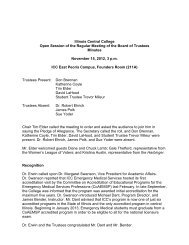Physical Therapist Assistant Complete Program Information
Physical Therapist Assistant Complete Program Information
Physical Therapist Assistant Complete Program Information
Create successful ePaper yourself
Turn your PDF publications into a flip-book with our unique Google optimized e-Paper software.
ABILITIES AND SKILLS RELATING TO ESSENTIAL JOB FUNCTIONS<br />
The role of a <strong>Physical</strong> <strong>Therapist</strong> <strong>Assistant</strong> in the various health care settings requires academic,<br />
cognitive, physical, and environment work/demands. To be successful as a PTA student and PTA<br />
graduate, the following abilities are expected to be performed safely, ethically, and legally under the<br />
supervision of the physical therapist.<br />
Illinois Central College strives to provide reasonable accommodations as necessary to allow a PTA<br />
student to be successful while maintaining the integrity of the field of physical therapy and patient safety.<br />
Students who require assistance in review of reasonable accommodations should meet with ICC’s access<br />
services. Further information at: ww.icc.edu/future students/campusServices_accessServices.asp.<br />
In compliance with the American Disability Act, Illinois Central College and the PTA <strong>Program</strong> do not<br />
discriminate on the basis of disability in the administration of its educational policies, admission<br />
policies, student aid, and other college administered programs.<br />
The PTA must have the abilities and skills necessary to provide competent patient care, which include<br />
observation, communication, motor ability, intellectual-conceptual abilities, and behavior/social<br />
attributes. Technological compensation can be made for some disabilities in certain areas, but the PTA<br />
should be able to perform in a reasonably independent manner.<br />
The following abilities and skills are necessary in order to perform the duties of a PTA:<br />
1. Observation: The PTA must be able to observe a patient accurately at a distance and close at hand.<br />
Observation necessitates the functional use of the sense of vision and somatic sensation. It is<br />
enhanced by the functional use of the sense of smell. The PTA must recognize a change in patient<br />
status in which the supervising physical therapist must be notified.<br />
2. Communication: The PTA must be able to speak, hear, and observe patients in order to provide<br />
instructions and elicit information; describe changes in mood, activity, and posture; and perceive<br />
nonverbal communications. A PTA must be able to communicate effectively and sensitively with<br />
patients. Communication includes not only speech but reading and writing. The PTA must be able<br />
to communicate effectively and efficiently in oral, written, and electronic form with<br />
patients/clients/consumers, co-workers, all members of the health care team, and other disciplines,<br />
while respecting cultural diversity. The PTA must have the ability to read and comprehend clinical<br />
textbooks and other education resources, procedures, numbers, and graphs displayed in print, on a<br />
video, or computer monitor.<br />
3. Motor Ability: PTA’s should have sufficient motor function to elicit information from patients<br />
including: performing full-body range of motion, handling, moving/transferring of patients; utilizing<br />
finger dexterity and eye-hand coordination; bending, reaching, pulling, pushing, and independently<br />
be mobile repeatedly throughout an 8-hour period; independently walk on all surfaces and stairs,<br />
throughout an 8-hour period unaided; frequently move and/or transfer patients and equipment using<br />
correct body mechanics; performing bilateral upper extremity activities, including coordination of<br />
both gross and fine muscular movement; demonstrating functional visual and auditory acuity with<br />
correction and/or accommodations, if needed; tolerating noxious odors, perfume, unsightly wounds<br />
and skin conditions; and manipulating common patient care items such as gait belts, blood pressure<br />
cuff, and wheelchairs. The PTA must have sufficient motor skills to treat patients in a variety of<br />
PTA <strong>Program</strong> Info 7-2013.doc Page 16 of 20


